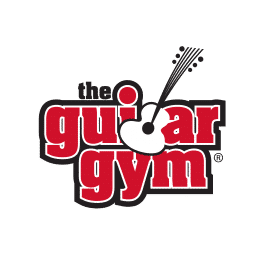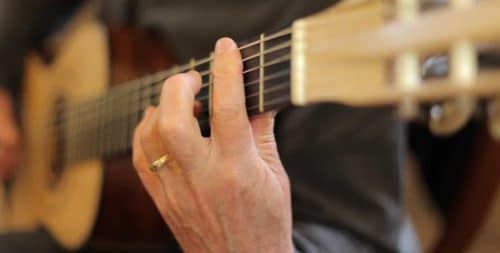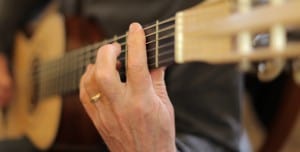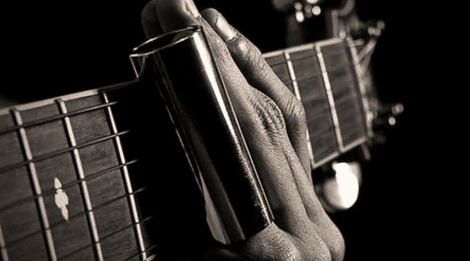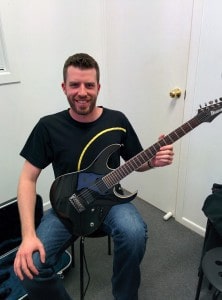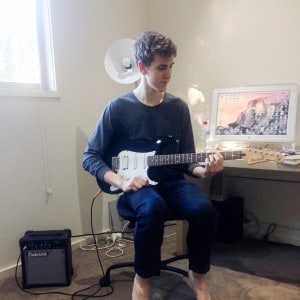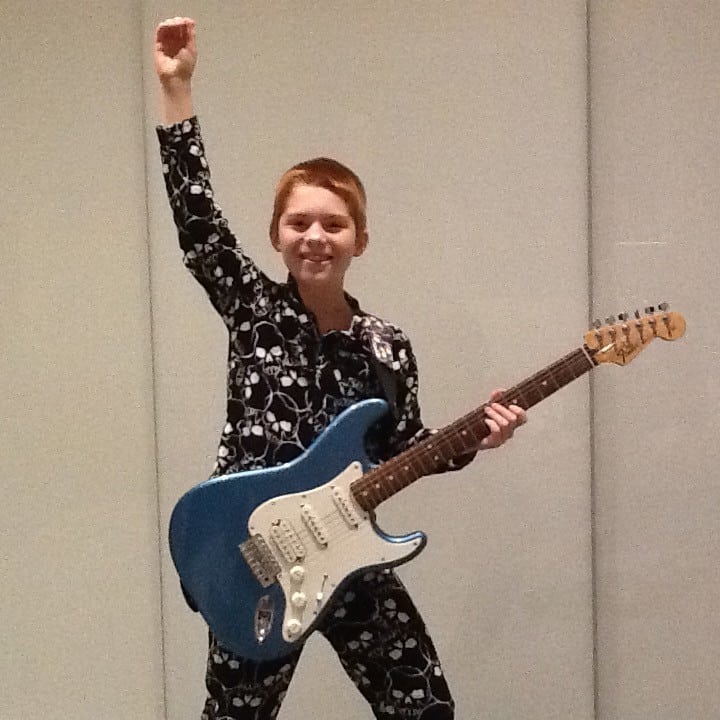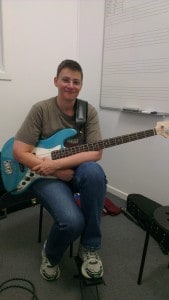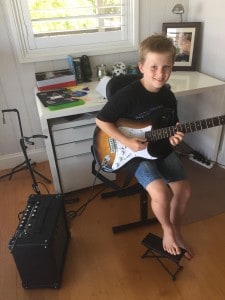When a client of ours quits, we hold ourselves 100% responsible. Why? Because we have failed them. They come to us for help. They want to get better at guitar and achieve specific things with their instrument. If they quit, we as their coach have obviously failed to provide adequate help and support where it really counts….in their head. Nobody really needs us to teach them about music or how to play the guitar. That information is freely or cheaply available everywhere. (For more on this, please read our article “The Benefits of Having A Guitar Teacher”)
The battle is won or lost in the mind. Succeeding at the guitar has nothing to do with natural talent (there is no such thing), having “musical bones” in your body, being too old, or having fat fingers. Success is 100% dependant on developing a mindset that is conducive to improvement over the long term. Key to such a mindset is having realistic expectations, both in terms of improvement and time devoted to one’s guitar practice.
Many people and especially adults we commence working with hold certain beliefs which are detrimental to succeeding with their guitar playing. Many parents also hold beliefs that are to the detriment of their child’s guitar playing. Largely these beliefs reflect “conventional wisdom”. There is so much total nonsense out there floating around that must have been perpetuated over the decades by archaic and obsolescent music teachers. Amidst this sea of garbage, of most significance are beliefs about practice.
“I’m too busy to practice.”
This is by far the most common explanation provided by people when they quit. But what are they really telling us here?
There are likely to be several things going on for the person, and none of them have anything to do with available time. In these cases, while the person may genuinely believe they are too busy to practice, in reality they are not. (And anyway, who said anyone had to practice?..more on this in Are You Really Too Busy To Play Learn Guitar?)
An understanding of the likely cognition (mental processing) that a person has undergone when they arrive at the decision to quit lessons citing this reason is essential in order for any music coach to become effective in their role. Recognising the prevalence of the issue in question, effective communication with a client by an astute music coach in the early days of the working relationship will surely prevent the client from giving up unnecessarily. What’s more, with an awareness of the cognitive processes at work in their own minds, the client will be in the best position to maximise their chances for success. And after all, our job as guitar coaches is to ensure our clients succeed.
Cognitive Dissonance
In my early teaching days, I started to see the whole “I’m too busy to practice” issue was something that most people needed help with. I recalled the term “Cognitive Dissonance” from my psychology studies at university. I got out an old textbook and read up on it again, and started to think how this concept applied to my clients.
In psychology, cognitive dissonance is the excessive mental stress and discomfort experienced by an individual who:
- holds two or more contradictory beliefs, ideas, or values at the same time; or
- is confronted by new information that conflicts with existing beliefs, ideas, or values. This stress and discomfort may also arise within an individual who holds a belief and performs a contradictory action or reaction.
Leon Festinger’s theory of cognitive dissonance focuses on how humans strive for internal consistency. When inconsistency (dissonance) is experienced, individuals largely become psychologically distressed. His basic hypotheses are listed below:
The existence of dissonance, being psychologically uncomfortable, will motivate the person to try to reduce the dissonance and achieve consonance. When dissonance is present, in addition to trying to reduce it, the person will actively avoid situations and information which would likely increase the dissonance.
Stress and discomfort may also arise within an individual who holds a belief and performs a contradictory action or reaction.
By applying Festinger’s theory we can start to explain the whole “I’m too busy to practice” scenario.
Let’s put this theory into some applicable equations!
In general:
Satisfaction = Perceived Reality – Expectation
If Satisfaction = 0 or >0
The person achieves as expected or better so cognitive consonance is achieved. The person is happy/not stressed.
If Satisfaction = <0
The person fails to achieve expectation so there will be cognitive dissonance. The person will be stressed and will take action to reduce the dissonance.
Specifically in terms of practice:
Satisfaction = Actual Practice Done – Self Imposed Practice Expectation
Example
Jimmy believes he needs to practice half an hour a day, 5 days a week, if learning guitar is going to be worthwhile. Jimmy practices for half an hour only 2 times a week for 4 weeks.
Satisfaction = (2×30) – (5×30) = -(3×30)
Satisfaction is <0
Jimmy experiences cognitive dissonance as he is not meeting his practice expectations. He is therefore stressed about guitar playing. There is likely to be a lot of negative self-talk going on in his mind:
“I should be practicing more”
“I’m just lazy”
“Where is my self discipline?”
“I’ve had a terrible day at work, I just don’t feel like it.”
“Man, this is SO hard!”
“I’m just not getting anywhere”
Jimmy seeks to resolve his cognitive dissonance. What are his options?
Look at the equation.
1. Jimmy could lower his expectations.
In fact, he could lower them to ZERO. If expectations are ZERO, dissonance cannot occur. Stress free!
2. Jimmy could increase his practice to meet his expectations.
But if it was that easy, he’d be doing it anyway, right? Well, there is a compounding problem here. Jimmy isn’t meeting his practice expectations because he is AVOIDING practice. He wants to practice more, but actively AVOIDS it! Why? Because he finds practice hard so it creates stress too! And this is the key to why people don’t simply just do the practice they expect to do. They will actively avoid playing because their actual ability does not meet their desired ability. If it feels hard for Jimmy, and he feels as though he isn’t achieving, he’ll avoid it. This is where the “I’m too busy” excuse comes in. This is how people justify the avoidance behaviour. People are never really too busy to practice, not for prolonged periods of time. It’s just what they tell themselves because it seems a reasonable self-justification. The constant prioritisation of all other things forms part of the avoidance behaviour. Most adults have full time jobs, a family, children, etc. But time in the day is there if you want it to be. It may not be a whole and undisrupted 30 minutes, but you don’t necessarily need that! In Jimmy’s case, practice in itself creates stress, which compounds the stress of not meeting his practice expectations. Remember Festinger’s theory? The person will actively avoid situations and information which would likely increase the dissonance. So even though the dissonance created by practice (not meeting performance/playing expectation) is a separate equation to the dissonance created by not meeting practice expectation, it’s all stress for Jimmy!
3. Jimmy could quit guitar altogether.
Sadly, for many people, this is the choice they take. It’s the easy way out. Unfortunately, the stress is often replaced by regret, as they’ve given up on something they really wanted to do.
Cognitive Dissonance Is The Driver For Improvement
The irony is, that while cognitive dissonance leads to quitting for some people, it is the driver for improvement.
Let’s look at an equation again:
Satisfaction = Perceived Ability – Desired Ability
If Satisfaction = 0
The person reached their desired level of ability, so cognitive consonance is achieved and therefore there will not be any drive for further improvement. Hence the term “raising the bar.” Increasing desired ability further is necessary for continued improvement.
If Satisfaction = <0
The person has not yet reached their desired level of ability, so cognitive dissonance drives the person to improve further such that dissonance is resolved. This is also why many high achievers are never satisfied and may struggle to be happy.
You may notice I have used the term “Perceived Ability” in the equation. This is very important. It is one’s own belief about their ability that is important. As demonstrated by many contestants on American Idol, some people simply increase perceived ability by believing they are much better than they actually are in order to resolve their cognitive dissonance!
Some Final Remarks
Of course, we generally advocate practising. However, a practice program should be carefully developed through consultation between client and coach. It must factor in the individual circumstances of the client and be achievable. Start small. Success breeds success. Achieving the completion of a practice program will make you feel successful in itself. Learn to identify negative self talk and understand what’s really happening in your head and why. Recognise improvement, don’t dwell on practice. Don’t lose sight of the big picture. You have a fundamental desire to play guitar so don’t quit unnecessarily!
